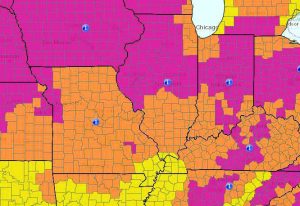Metro East Area News Briefs
Chronicle Media — January 16, 2019
Map illustrates counties with the highest levels of radon exposure (in red), lower but still above average levels (light yellow) and below average level (bright yellow). (Map courtesy of U.S. EPA)
EPA: Metro East, Jersey County at risk for radon,
The U.S. Environmental Protection Agency (EPA) is urging residents across the Metro-East to test for radon — an odorless, colorless, radioactive gas that can seep into homes and, at high levels of exposure, can cause lung cancer in some people.
Madison, St. Clair and Clinton counties sit near the center of a wide swath of the central U.S., which studies have shown to have higher-than-average indoor radon exposure rates, according to the EPA.
The EPA places Jersey County in the highest risk category for indoor radon exposure.
The agency recommends homeowners in areas test to determine if their specific dwellings are subject to high levels of radon exposure and, if so, consider home improvements to mitigate the risk.
Radon is the second-highest cause of lung cancer in the United States, behind smoking. Roughly 21,000 Americans die of radon-related lung cancer every year, according to the EPA, and approximately 2,900 of those deaths are among people who have never smoked. It is estimated nearly 1,200 people in Illinois develop radon-related lung cancer each year.
In addition to the three core Metro East counties, the radon advisory covers the neighboring Southern Illinois counties of Bond, Clinton, Randolph and Washington, as well as the entirety of the Missouri side of the Greater St. Louis area, encompassing the City of St. Louis, St. Louis County, St. Charles County, Jefferson County and Franklin County.
Jersey County lies at the Southern tip of a wide ban of central to northern Illinois counties found to have highest average levels of indoor radon exposure, according to the EPA.
The three southernmost counties in Illinois tend to experience lighter than average radon exposure, according to the agency.
The EPA renewed its call for radon testing and remediation last week as part of its annual January observance of National Radon Action Month.
Technically, Jersey County and most Illinois counties to the north are classified by the EPA as Zone 1 areas, with predicted average indoor radon screening levels greater than 4 pCi/L .
Madison, St. Clair and Clinton counties, as well as most the rest of the surround area are classified at Zone 2 areas, with predicted average indoor radon screening levels from 2 to 4 pCi/L .
EPA classified Zone 3 counties, such as those found in the tri-state area around the Missouri Boot Heel, have predicted average indoor radon screening levels less than 2 pCi/L .
For those who wish to test their dwellings for radon, the Illinois Emergency Management Agency (IEMA) offers a referral list of providers for low-cost list radon test kits and detectors. Radon tests can also be purchased through many home improvement centers, hardware stores, and online vendors.
Commercial radon testing services are available — however, in Illinois, all such services must be licensed, the IEPA emphasizes. The agency offers a statewide list of licensed radon measurement professionals.
The IEMA recommends carefully assessment of all costs that may be involved, from kit costs to packaging and lab fees.
Should test results indicate a high level of radon in a home, the owners should consider remediation through a state licensed professional, according to the IEPA.
The IEPA also offers a statewide list of radon remediation providers. The list and other IEPA radon services can be accessed at https://tinyurl.com/IEPAradon.
The Madison County Health Department (MCHD) offers one of the state’s more comprehensive local radon programs.
The department offers county residents radon test kits for purchase; complete with instructions from staff on use of the test and other guidance.
The department can also provide lists of licensed radon measurement professionals and licensed radon mitigation professionals in the area.
The department provides presentations on radon gas, testing, and mitigation. For more information on any of the department’s services, (618) 296-6079.
State of Illinois now has oversight on drones
At least on the Illinois side of the St. Louis area, the regulation of unmanned aerial vehicles (UAV) — popularly known as drones — is no longer a matter for debate, the Bi-State Development Agency noted in a statement last week.
An update to the Illinois Aeronautics’ Act, signed in August by Gov. Bruce Rauner and now in effect, makes UAV oversight in Illinois an exclusive power and function of the state, according to Linda Schumm, bureau chief of Aviation Safety and Education for the Illinois Department of Transportation’s Division of Aeronautics.
Schumm reported during the second in a series of forums on drone regulation, sponsored by Bi-State and its St. Louis Downtown Airport in Cahokia, which has been attempting to develop a consistent approach to drone regulation across the St. Louis area.
Developed by an Illinois Unmanned Aerial System Oversight Task Force, in conjunction with the Federal Aviation Administration (FAA), the new state law effectively bars counties or municipalities from enacting drone regulations.
The state can control where a drone takes off from and where it lands, Schumm said.
Once in the air, “as soon as it leaves the ground, it is now under the control of the FAA,” she added.
Previously existing state law protecting personal privacy, restricting what Illinois State Police can do with their drones and a Department of Natural Resources statute that prohibits use of a drone to find animals when hunting or fishing.
Missouri officials are still grappling with drone regulation, conference attendees noted.
Casino Queen leads gaming-hall downturn across state
Adjusted gross revenues (AGR) at Illinois’ 10 riverboat casinos decreased during 2018, compared with 2017, according to cumulative data compiled by the Illinois Gaming Board.
Statewide casino revenues fell 6.7 percent to $10,913,072 in 2018 from $11,696,932 during the previous year.
The Casino Queen in East St. Louis took the biggest hit; down 12.22 percent to $945,568 in 2018 from $1,07,190 in 2017.
The Argosy Casino in Alton continued to be the state’s lowest-grossing gaming house, last year. However, it was the least affected by the revenue downturn. Argosy revenues inched down just 1.75 percent last year — to $486,1142 in 2018 from $494,821 in 2017 — the smallest decline in the state.
All 10 Illinois casinos (Alton’s Argosy, East Peoria’s Par-A-Dice, the Jumers Casino in Rock Island, The Hollywood Casino in Joliet, the Harrahs casinos in Metropolis and Joliet, the Hollywood Casino in Aurora, the Casino Queen in East St. Louis, the Grande Victoria in Elgin , and the Rivers Casino in Des Plaines) saw year-over-year revenue declines last year, according to the gaming board data.
Industry analysts general blame increased competition from video gaming.
Statewide casino admissions fell 7.49 percent. However, gamblers, on average, lost more with gross revenue per admission up 5.18 percent.
Although revenues from table games at the Casino Queen increased 1.56 percent last years, that was offset by a 6.85 percent drop in electronic gaming revenues.
The ten casinos produced $38,824,695 in tax revenues for the State of Illinois and a total of $6,183,548 in tax revenues for host municipalities.
Better land management may help native birds
Landowners, enrolled in the U.S. Department of Agriculture’s popular Conservation Reserve Program (CRP) could help ensure the survival of prairie bird populations with a few changes in land management practices, according to research published this month in Britain’s Journal of Applied Ecology by researchers at Godfrey’s National Great Rivers Research and Education Center’s (NGRREC) .
“Our research demonstrated that tractor-based management, such as light-strip discing, and establishing native-grass practices on private grasslands … can improve nest survival of multiple grassland bird species and communities,” said NGRREC Conservation Program Manager Justin Shew.
The research is important because many grassland bird populations in North America have been consistently declining for decades and properly guided management decisions may help alleviate those declines, he adds. North American grassland birds nest predominantly on private land.
The Conservation Reserve Program (CRP) provides payments to agricultural producers to take highly erodible and environmentally sensitive land — particularly when marginal for farming — out of crop production and install resource conserving practices for 10 or more years.
Conservation reserve programs, originally established to enhance soil and water quality, have long been recognized as beneficial to wildlife. However, the study suggests federal and state authorities need to do more to explain to farmers the importance of land management to the preservation of native animal populations.
The NGRREC is now working to disseminate the study findings to Southern Illinois farmers, as well as well as to a broader base through its network of Land Conservation Specialists stationed remotely with Illinois Department of Natural Resources (IDNR) and the federal Natural Resources Conservation Service (NRCS).
The British journal is making the study available free of charge online through Jan. 21, at https://besjournals.onlinelibrary.wiley.com/doi/10.1111/1365-2664.13317.
–Metro East Area News Briefs–








